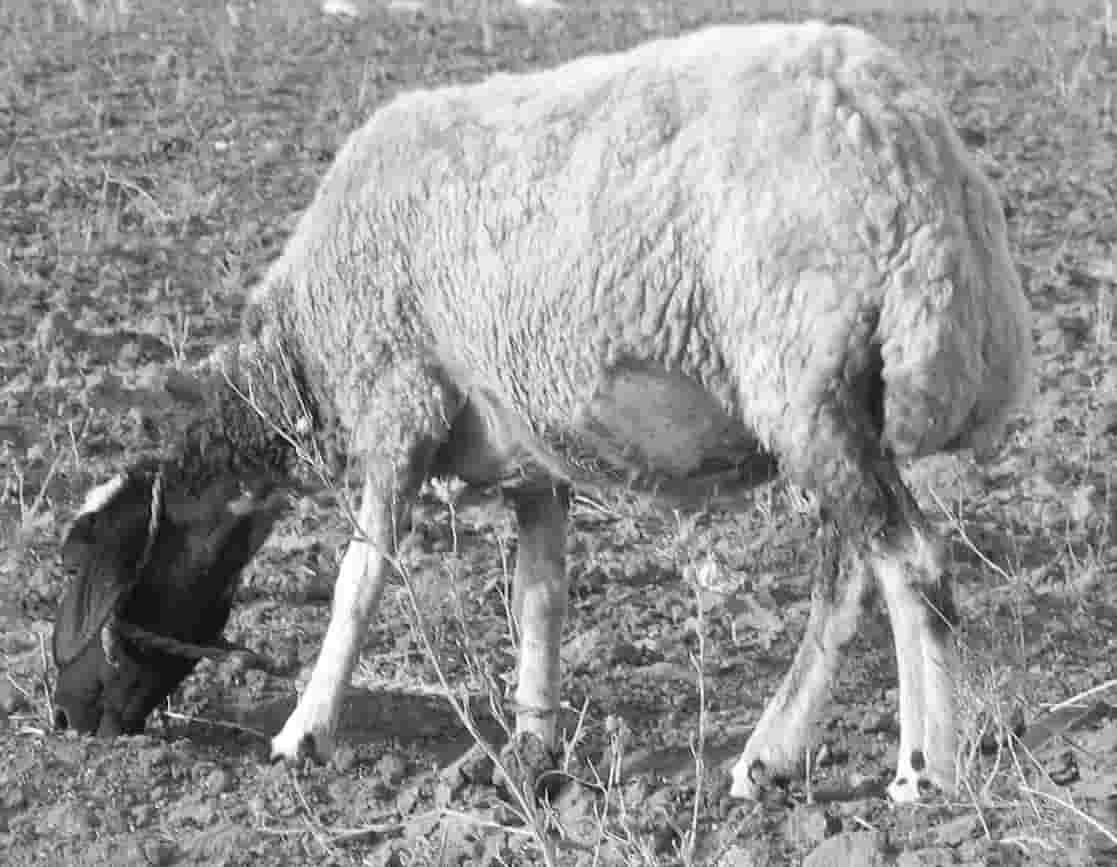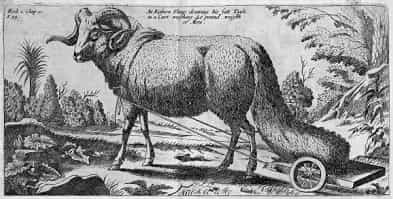With פרשת ויקרא we start talking about all the gross anatomic details of the קרבנות. In the case of the שלמים, the meat is eaten by the people and the fats are burned on the altar:
{:he}
><b>א</b> ואם זבח שלמים קרבנו אם מן הבקר הוא מקריב אם זכר אם נקבה תמים יקריבנו לפני ה׳׃...<b>ג</b> והקריב מזבח השלמים אשה לה׳ את החלב המכסה את הקרב ואת כל החלב אשר על הקרב׃ <b>ד</b> ואת שתי הכלית ואת החלב אשר עלהן אשר על הכסלים; ואת היתרת על הכבד על הכליות יסירנה׃
>
...<b>יב</b> ואם עז קרבנו והקריבו לפני ה׳׃...<b>יד</b> והקריב ממנו קרבנו אשה לה׳ את החלב המכסה את הקרב ואת כל החלב אשר על הקרב׃ <b>טו</b> ואת שתי הכלית ואת החלב אשר עלהן אשר על הכסלים; ואת היתרת על הכבד על הכלית יסירנה׃
--ויקרא פרק ג
But there is something different about the שלמים of a sheep:
{:he}
><b>ז</b> אם כשב הוא מקריב את קרבנו והקריב אתו לפני ה׳׃...<b>ט</b> והקריב מזבח השלמים אשה לה׳ חלבו האליה תמימה לעמת העצה יסירנה; ואת החלב המכסה את הקרב ואת כל החלב אשר על הקרב׃ <b>י</b> ואת שתי הכלית ואת החלב אשר עלהן אשר על הכסלים; ואת היתרת על הכבד על הכלית יסירנה׃
--ויקרא פרק ג
The אליה, the tail, of a sheep is burned on the altar, and the Torah emphasizes that this is something different from the other חלב:
{:he}
><em>אם כשב</em>: לפי שיש באמורי הכשב מה שאין באמורי העז, שהכשב אליתו קרבה, לכך נחלקו לשתי פרשיות.
--רש״י, ויקרא ג:ז
What is special about the sheep tail?
{:he}
>לא הזכיר האליה כי אם בכבש...כי הכבשים שהן בארץ ישראל יש להם אליה גדולה וזה דבר ידוע
--אבן עזרא, ויקרא ג:יב

--A Tunisian Babarin fat-tailed sheep (RAMAGRI-CC BY-SA 4.0), [_For Thousands of Years, People Have Been Obsessed With Fat-Tailed Sheep_](https://www.atlasobscura.com/articles/what-is-a-fat-tailed-sheep)
>The fat-tailed sheep is a general type of domestic sheep known for their distinctive large tails and hindquarters. Fat-tailed sheep breeds comprise approximately 25% of the world's sheep population, and are commonly found in northern parts of Africa, the Middle East, and various Central Asian countries all the way to China. The tail fat from those sheep is an important ingredient in many regional cuisines.
--Wikipedia, [_Fat-tailed sheep_](https://en.wikipedia.org/wiki/Fat-tailed_sheep)
And once you start breeding animals for a particular characteristic, it can get pretty extreme:
>The tails of Awassi sheep can weigh around 26 pounds, which is modest compared to an 80-pound sheep tail described by 16th-century chronicler Leo Africanus.
--Anne Ewbank, [_For Thousands of Years, People Have Been Obsessed With Fat-Tailed Sheep_](https://www.atlasobscura.com/articles/what-is-a-fat-tailed-sheep)

--[_Fat-tailed sheep pulling a cart to protect its tail as depicted in Job Ludolphus' (Ludolf the Elder's) A New History of Ethiopia (1684)](https://commons.wikimedia.org/wiki/File:Fat-Tailed_Sheep.png)
{:he}
>אין חמור יוצא במרדעת בזמן שאינה קשורה לו...ואין התרנגולין יוצאין בחוטין...ואין הזכרים יוצאין בעגלה שתחת האליה שלהן.
--משנה שבת ו:ד
----
What is interesting about the אליה is that it is burned on the altar when it is part of a קרבן שלמים, but it isn't חֵלֵב, part of the forbidden fats that are not kosher. "An important ingredient in many regional cuisines" includes ancient Israel.
{:he}
> <b>כג</b> ויאמר שמואל לטבח תנה את המנה אשר נתתי לך אשר אמרתי אליך שים אתה עמך׃ <b>כד</b> וירם הטבח את השוק וְהֶעָלֶיהָ וישם לפני שאול ויאמר הנה הנשאר שים לפניך אכל כי למועד שמור לך לאמר העם קראתי; ויאכל שאול עם שמואל ביום ההוא׃
--שמואל א פרק ט
{:he}
>מאי ”והעליה“? ר' יוחנן אומר שוק ואליה. מאי והעליה? דמסמכא שוק לאליה.
--עבודה זרה כה,א
><em>והעליה</em>: Meaning of Heb. uncertain. Emendation yields “the broad tail.”
--JPS 1985 Translation, I Samuel 9, footnote 7
{:he}
>ההוא ארמאה דהוה סליק ואכיל פסחים בירושלים. אמר: כתיב ”כל בן נכר לא יאכל בו“, ”כל ערל לא יאכל בו“ ואנא הא קאכילנא משופרי שופרי. אמר ליה רבי יהודה בן בתירא: מי קא ספו לך מאליה? אמר ליה: לא. כי סלקת להתם אימא להו: ספו לי מאליה. כי סליק אמר להו: מאליה ספו לי. אמרו ליה: אליה לגבוה סלקא. אמרו ליה: מאן אמר לך הכי? אמר להו: רבי יהודה בן בתירא, אמרו: מאי האי דקמן? בדקו בתריה ואשכחוהו דארמאה הוא.
--פסחים, ג,ב
----
Why do I bring this up?
>G-d is in the details.
--[Ludwig Mies van der Rohe](https://www.brainyquote.com/quotes/ludwig_mies_van_der_rohe_101419)
>G-d is in de-tails.
--me
----
But we would like to see some kind of deeper meaning to this fat tail.
Why should it be offered on the altar? A קרבן שלמים is not a sacrifice; it's a shared barbecue. If the tail is a delicacy, then we should be allowed to eat it.
Hirsch looks at the symbolism of the חֵלֵב but can't come up with an answer.
>...So, for example, the חלב כליות of the lower urges, חלב הקרב of nutrition. Unfortunately, we lack the physiological knowledge of the meaning of כסלים and of the אליה to be able to follow up this suggestion with regards to these parts.
--Hirsch Chumash, Leviticus III:9
Rabbi Yehoshua Weitzman of Yeshivat Ma'alot has a suggestion, based on the physiological purpose of the fat tail:
>These hind parts are used to accumulate fat for subsequent use during dry seasons, similar to a camel's humps.
--Wikipedia, [_Tail fat_](https://en.wikipedia.org/wiki/Tail_fat)
{:he}
>מה קורה לכבשה שמאבדת, חלילה, את העדר?
>
לשם כך יש לכבשה אליה--מחסן של חלב ושומן. כשהכבשה אוכלת, האליה מתמלאת שומן, וכך יש לכבשה ”רזרבות“, שמשמשות
אותה כשהיא בגלות. בגלל שהכבשה זקוקה לעדר ולרועה, היא זקוקה ליכולת להתנהל גם כשהעדר מתפזר. זוהי האליה--”תכנית החסכון“ של הכבש לזמנים קשים.
--הרב יהושע ויצמן (ישיבת הסדר מעלות יעקב), [_לחיות עם פרשת השבוע--תסתדר בעצמך!_](https://yesmalot.co.il/59562/)
Throughout תנ״ך and the Talmud, a lost sheep is a symbol for Israel in exile.
{:he}
><b>א</b> לא תראה את שור אחיך או את שיו נדחים והתעלמת מהם; השב תשיבם לאחיך׃...<b>ג</b> וכן תעשה לחמרו וכן תעשה לשמלתו וכן תעשה לכל אבדת אחיך אשר תאבד ממנו ומצאתה; לא תוכל להתעלם׃
--דברים פרק כב
The gemara has מדרש הלכה reasons for three of these four examples, שור,‎ חמור and שמלה. But there is no reason for the שה. The Maharsha says we need it for a מדרש אגדה:
{:he}
>”שה“ דכתבה בפרשת אבדה לכ״ע קשיא, דלא איצטריך ליה. וע״ז…אומר (תהלים קיט:קעו) תָּעִיתִי כְּשֶׂה אֹבֵד; בַּקֵּשׁ עַבְדֶּךָ. ר״ל כשה האובד האמור בפרשת אבדה דלא איצטריך ליה בקרא, אבל הוא רמוז על ישראל הנקראים ”שה פזורה“, והם המה שה דאבדה שבתורה שהש״י ב״ה הוא בעליו של אותו השה, ומבקשו להוציא מאבדתו מן הגלות.
--מהרש״א, חידושי אגדות, מכות כד,א
So the אליה symbolizes our stored-up ability to survive in exile, to draw on our past successes even in hard times. And the important thing to realize is that this success comes from הקב״ה.
{:he}
>אנדריאנוס קיסר אמר לו לרבי יהושע: גדולה היא הכבשה שעומדת בין שבעים זאבים. אמר לו: גדול הוא הרועה שמצילה ושוברן לפניהם.
--אסתר רבה י:יא
{:he}
>אנו מקריבים את האליה על המזבח, ובכך מודים לה׳ על כך שהוא נותן לנו יכולת לשרוד גם בתקופות של גלות.
--הרב יהושע ויצמן (ישיבת הסדר מעלות יעקב), [_לחיות עם פרשת השבוע--תסתדר בעצמך!_](https://yesmalot.co.il/59562/)